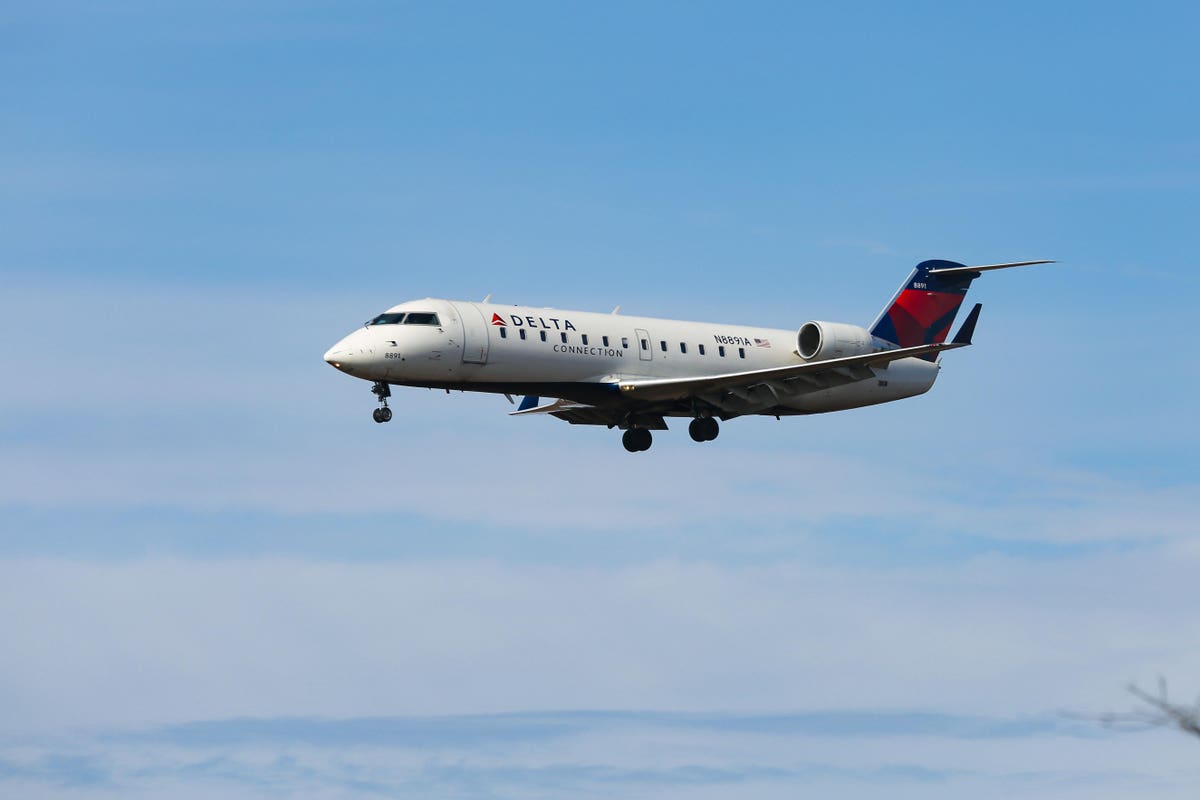In the mid-1990s, the 50-seat regional jet promised a big upside. Large U.S. airlines that used regional airlines to feed their hubs were using aircraft with props, like the Bombardier Dash-8 or the ATR-42. The 50-seat regional jet, first made by Bombardier as a modification of their popular business jet, offered smoother flights, no middle seats, faster flying, and a perceived revenue advantage. Revenue models at the time estimated that customers would pay more to fly on a jet versus a turboprop. Add to this that airlines could use these jets for regional feed without violating their pilot contracts, and the big U.S. airlines placed orders for hundreds of Bombardier CRJs and its Embraer competitor. Shortly after delivering many 50-seat jets, the suppliers soon offered 70 and 90-seat varieties. A shrunken version to only 35 seats was also made, and American Airlines used this for short distance flight along the east coast.
Now its almost 30 years later, and the world has changed. Airlines have realized the value of seat economics versus trip economics, and up-gauging of fleets has been popular at every airline. Pilot wages have increased, and some carriers now must pay pilots as much to fly 50 people as to fly 150 people. The revenue premium expected never materialized with consistency. These changes have made it impossible to deploy the 50-seat and smaller jets profitably.
Regional Fleets And Pilot Scope Clauses
Regional aircraft are generally thought of as those under 100 seats. Until the 1990s these were all powered by turboprops. The planes were reliable, low-cost to operate, pretty fuel efficient, and often could operate on short runways. This was important because these were sometimes common at airports in smaller cities. When Bombardier created the CRJ, this was a game-changer as it looked and operated like a full-size jet, but still had initially only 50 seats.
Pilot contracts in the U.S. have a scope clause. These clauses protect the union by limiting what capacity can be hired by the airline that doesn’t use pilots covered by the contract. Many such scope clauses give the big airlines the ability to outsource flying to regional carriers as long as the aircraft are small enough. This scope relief is the primary reason that initially there were so many 50-seat jets produced and deployed, and created strong demand for the 70-seat jet as well. In the 1980s, airlines still looked for smaller jets to fly domestically to smaller cities. American’s order for the Fokker-100 in the early 1990s was in some ways the first regional jet order, even though it was flown by the big airline. That’s because, at the time, it was a reasonable small jet option.
Economics Of Fleet Up-Gauging
Airplanes have been getting larger, for several reasons. The most relevant cost metric for airlines is known as CASM, or cost per available seat mile. The “ASM” portion of this metric is calculated by multiplying the seats on a plane by the number of miles it flies. Thus, the more seats or the longer the trip, the more ASMs. When dividing these ASMs into the airline’s cost to operate the flight, a bigger denominator means a smaller total number. This basic math means that larger airplanes deliver lower unit costs, and that is why, to some extent, 50-seat jets were replaced by 70-seat jets, who were then replaced by 90-seats jets.
Access at bigger airports is another reason. The largest hubs in the U.S. — like Atlanta, Chicago, Dallas, and Denver — are also very busy and constrained. If a single plane brings in 50 people, they still use time on the runways and taxiways, and park at a gate for while. A 90-seat jet uses no more physical resource, and may use less if it flies faster. So, larger equipment is a way to become more efficient in constrained real estate. The Airbus A380 was an extreme attempt to address this. Airbus bet that huge cities like London, New York, and Hong Kong would become so constrained that having a massive airplane would be the way of the future. This hasn’t proven to be needed yet, but when going from 50 to 90 or more the economics are proven.
Pilot Wage Realities
Flights under eight hours require two pilots, no matter how many seats are on the plane. The market for pilots has become highly constrained. The military, once a regular source of commercial airline pilots, no longer provides a large and steady pipeline. The 1500 hour rule, a Federal Aviation Administration (FAA) regulation passed in 2012, has made it very expensive to train to be a pilot. For decades, pilots could join a commercial airline with 250 hours, and apprentice with a seasoned captain as they grew in experience. This was seen as safe, and is still used by the rest of the world.
Add to this that the industry keeps growing and needs an ever-increasing pool of pilots. As a result, pilot wages are high and getting higher. It is challenging for airline operators to make flights financially profitable if there isn’t enough revenue to cover all the costs, including the big increases in the cockpit. This means bigger airplanes are more profitable, generally. A 90-seat plane can carry 80% more revenue than a 50-seat plane, but still uses only two pilots. Other operating costs, like landing fees and fuel, also increase by far less than 80%. But it’s the pilot cost increases, among the regionals, that is driving most of the equipment size up-gauging.
Impact of Low-Cost Carriers
Low-cost airlines have been growing, both in the U.S. and around the world. Low-cost airlines get their low costs by being simple and being efficient. Since airline customers are highly price elastic, meaning that with a small drop in price, many more people buy the product, low-cost airlines tend to use larger average aircraft and stuff them with seats. In the 1980s, Southwest airlines played this game, using the Boeing 737 to fly routes that bigger airlines flew with their regional partners on turboprops.
Today, carriers like JetBlue, Spirit, Frontier, and more collectively serve a national network and affect the pricing in all but the smallest cities. This means that small aircraft, like the 50-seat jets, can’t command a revenue premium but also can’t generate enough revenue at the prices now available. In the 1980s, American Airlines’ CEO Bob Crandall used to say that smaller planes were the way to go. This was because they could charge high fares, and extra seats put downward pressure on the fares. In a world with high pilot costs and low-cost carriers everywhere, this strategy no longer works.
Wither The 70 and 90-Seat Models?
All of these arguments aren’t solved by moving to 70-seat or even 90-seat equipment. The most efficient narrow body aircraft sold today is the Airbus A220, and the smallest model can carry 135 people. This plane has largely made the Airbus A319, a shorter version of the popular A320, economically obsolete. With these realities, it’s hard not to expect that the 70 and 90-seat regional jets will also eventually go away. Of course, the 90-seat jets will hold on the longest.
If this is true, it begs the question of what happens to the regional airlines in the U.S. Carriers like Republic, Skywest, and Mesa employ thousands of people, and carry a good chunk of the traveling public. Big airlines employ them to fly because they are more cost efficient, both in labor and other areas. As technology replaces people in airports, and pilot wages continue to grow, the role of the regional carrier is suspect. Enjoy your next trip on a 70-seat jet, knowing that you are flying on a plane that is the mechanical version of the dodo bird.
Read the full article here





